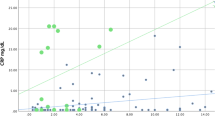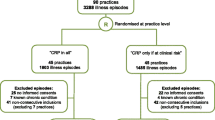Abstract
Recently C-reactive protein (CRP) point-of-care tests have been developed. We aimed to validate a bedside CRP test (QuikRead go® CRP), to compare it with the laboratory CRP (ARCHITECT c8000 Abbott, Germany) test in children with fever without source (FWS), and to evaluate the optimal CRP cut-off value to identify those patients at a high risk for serious bacterial infection (SBI). The CRP bedside test was prospectively performed in capillary blood samples concurrently with the laboratory CRP testing for 283 well-appearing infants aged 1 to 24 months with FWS attending the emergency department (ED) between May 2013 and August 2015. The mean difference between the laboratory CRP and the QuikRead go CRP values was 0.71 mg/L (p = 0.444). Pearson’s correlation coefficient between the CRPs was r = 0.929 (p < 0.001). SBI was diagnosed in 34 patients (12.0%). The area under the receiver operating characteristics (ROC) curve obtained was 0.87 (95%CI: 0.82–0.90) for an optimal CRP cut-off value of > 10 mg/L (sensitivity: 94.1%, specificity: 49.0%, positive predictive value: 20.1%, negative predictive value: 98.4%), as a predictor of SBI. Nearly 45% of the patients were at a low risk for SBI according to CRP value; thus, additional laboratory tests would have been hypothetically avoided. There was a very strong, positive correlation between the QuikRead go CRP test and laboratory CRP determination. The QuikRead go CRP test provides reliable results to rule out SBI. Its implementation at the ED would improve the management of infants with FWS.

Similar content being viewed by others
References
Simon A, Lukacs S, Pauline Mendola P (2011) Emergency department laboratory evaluations of fever without source in children aged 3 to 36 months. Pediatrics 128:e1368–e1375. doi:10.1097/PEC.0b013e31828e56e1
Andreola B, Bressan S, Callegaro S, Liverani A, Plebani M, Da Dalt L (2007) Procalcitonin and C-reactive protein as diagnostic markers of severe bacterial infections in febrile infants and children in the emergency department. Pediatr Infect Dis J 26:672–677
Manzano S, Bailey B, Gervaix A, Cousineau J, Delvin E, Girodias J (2011) Markers for bacterial infection in children with fever without source. Arch Dis Child 96:440–446. doi:10.1136/adc.2010.203760
Nijman RG, Moll HA, Smit FJ, Gervaix A, Weerkamp F, Vergouwe Y, de Rijke YB, Oostenbrink R (2014) C-reactive protein, procalcitonin and the lab-score for detecting serious bacterial infections in febrile children at the emergency department: a prospective observational study. Pediatr Infect Dis J 33:e273–e279. doi:10.1097/INF.0000000000000466
Mor M, Waisman Y (2000) Point-of-care testing: a critical review. Pediatr Emerg Care 16:45–48
Singer AJ, Williams J, Taylor M, Le Blanc D, Thode HC Jr (2015) Comprehensive bedside point of care testing in critical ED patients: a before and after study. Am J Emerg Med 33:776–780. doi:10.1016/j.ajem.2015.03.034
Esposito S, Tremolati E, Begliatti E, Bosis S, Gualtieri L, Principi N (2005) Evaluation of a rapid bedside test for the quantitative determination of C-reactive protein. Clin Chem Lab Med 43:438–440
Papaevangelou V, Papassotiriou I, Sakou I, Ferentinos G, Liapi G, Kyrka A, Konstantopoulos A (2006) Evaluation of a quick test for C-reactive protein in a pediatric emergency department. Scand J Clin Lab Invest 66:717–721
Marcus N, Mor M, Amir L, Mimouni M, Waisman Y (2008) Validity of the quick-read C-reactive protein test in the prediction of bacterial pneumonia in the pediatric emergency department. Eur J Emerg Med 15:158–161. doi:10.1097/MEJ.0b013e3282f12f52
Diar HA, Nakwa FL, Thomas R, Libhaber EN, Velaphi S (2012) Evaluating the QuikRead® C-reactive protein test as a point-of-care test. Paediatr Int Child Health 32:35–42. doi:10.1179/1465328111Y.0000000045
Papa F, Rongioletti M, Majolini MB, Collegiani V, Vaccarella C, Notarmuzi ML, Cortesi M, Pasqualetti P, Cicchese M, Agostino R, Liumbruno GM (2012) Fast bedside measurement of blood count and C-reactive protein in newborns compared with conventional methods. Clin Lab 58:951–957
Galetto-Lacour A, Zamora SA, Gervaix A (2003) Bedside procalcitonin and C-reactive protein tests in children with fever without localizing signs of infection seen in a referral center. Pediatrics 112:1054–1060
Dieckmann RA, Brownstein D, Gausche-Hill M (2010) The pediatric assessment triangle: a novel approach for the rapid evaluation of children. Pediatr Emerg Care 26:312–315. doi:10.1097/PEC.0b013e3181d6db37
Marcus N, Mor M, Amir L, Mimouni M, Waisman Y (2007) The quick-read C-reactive protein test for the prediction of bacterial gastroenteritis in the paediatric emergency department. Pediatr Emerg Care 23:934–937. doi:10.1097/PEC.0b013e31814a6a52
Zecca E, Barone G, Corsello M, Romagnoli C, Tiberi E, Tirone C, Vento G (2009) Reliability of two different bedside assays for C-reactive protein in newborn infants. Clin Chem Lab Med 47:1081–1084. doi:10.1515/CCLM.2009.246
Waddle E, Jhaveri R (2009) Outcomes of febrile children without localising signs after pneumococcal conjugate vaccine. Arch Dis Child 94:144–147. doi:10.1136/adc.2007.130583
Wilkinson M, Bulloch B, Smith M (2009) Prevalence of occult bacteraemia in children aged 3 to 36 months presenting to the emergency department with fever in the postpneumococcal conjugate vaccine era. Acad Emerg Med 16:220–225. doi:10.1111/j.1553-2712.2008.00328.x
Pratt A, Attia MW (2007) Duration of fever and markers of serious bacterial infection in young febrile children. Pediatr Int 49:31–35. doi:10.1111/j.1442-200X.2007.02316.x
Yen K, Gorelick MH (2007) Strategies to improve flow in the pediatric emergency department. Pediatr Emerg Care 23:745–749. doi:10.1097/PEC.0b013e3181568efe
Peltola H, Jaakkola M (1988) C-reactive protein in early detection of bacteremic versus viral infections in immunocompetent and compromised hosts. J Pediatr 11:641–646
Pulliam P, Attia M, Cronan K (2001) C-reactive protein in febrile children 1-36 months of age with clinically undetectable serious bacterial infection. Pediatrics 108:1275–1280
Nijman RG, Moll HA, Vergouwe Y, de Rijke YB, Oostenbrink R (2015) C - reactive protein bedside testing in febrile children lowers length of stay at the emergency department. Pediatr Emerg Care 31:633–639. doi:10.1097/PEC.0000000000000466
Hsiao AL, Santucci KA, Dziura J, Baker MD (2007) A randomized trial to assess the efficacy of point-of-care testing in decreasing length of stay in a pediatric emergency department. Pediatr Emerg Care 23:457–462. doi:10.1097/01.pec.0000280506.44924.de
Luaces-Cubells C, Mintegi S, García-García JJ, Astobiza E, Garrido-Romero R, Velasco-Rodríguez J, Benito J (2012) Procalcitonin to detect invasive bacterial infection in non-toxic-appearing infants with fever without apparent source in the emergency department. Pediatr Infect Dis J 31:645–647. doi:10.1097/INF.0b013e31824dacf4
Hernandez-Bou S, Trenchs V, Batlle A, Gene A, Luaces C (2015) Occult bacteraemia is uncommon in febrile infants who appear well and close clinical follow-up is more appropriate than blood tests. Acta Paediatr 104:e76–e81. doi:10.1111/apa.12852
Author information
Authors and Affiliations
Corresponding author
Ethics declarations
Funding
This study was partly supported by Orion Corporation, Orion Diagnostica, Espoo, Finland, who provided the QuikRead go CRP instrument and kits for the study. No other external funding was received for this study. The study sponsor played no role in the study design; in the collection, analysis, and interpretation of data; in the writing of the report; or in the decision to submit the paper for publication.
Conflicts of interest
The authors declare that they have no conflicts of interest and that they do not have a financial relationship with the organization that sponsored the research.
Ethical approval
All procedures performed in studies involving human participants were in accordance with the ethical standards of the institutional and/or national research committee and with the 1964 Declaration of Helsinki and its later amendments or comparable ethical standards. The Ethics Committee of the Hospital Sant Joan de Déu Barcelona approved the study (CEIC PIC-45-13).
Informed consent
Signed informed consents were obtained from the parents or legal guardians of all participating children.
Rights and permissions
About this article
Cite this article
Hernández-Bou, S., Trenchs, V., Vanegas, M.I. et al. Evaluation of the bedside Quikread go® CRP test in the management of febrile infants at the emergency department. Eur J Clin Microbiol Infect Dis 36, 1205–1211 (2017). https://doi.org/10.1007/s10096-017-2910-2
Received:
Accepted:
Published:
Issue Date:
DOI: https://doi.org/10.1007/s10096-017-2910-2




